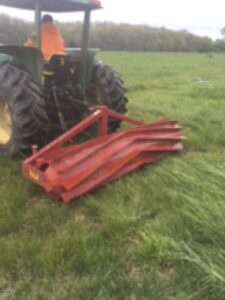Project Overview
Commodities
- Agronomic: grass (misc. perennial)
- Animals: bovine, equine, goats, sheep
- Animal Products: meat
Practices
- Animal Production: animal protection and health, feed/forage, grazing management, rangeland/pasture management
- Education and Training: demonstration, extension, on-farm/ranch research
- Energy: energy use
- Pest Management: physical control
Abstract:
In Missouri and the other central US states of the “Fescue Belt”, grazing management of Tall Fescue pastures includes management of fescue seed heads. Endophyte infected tall fescue has the highest concentration of the toxic alkaloids in the seed. Removing these heads reduces the negative animal health effects of grazing infected fescue. For many producers, this involves “clipping” pastures with rotary mowers. In addition to removing seed heads, the cutting/damage to upper canopy foliage stimulates additional vegetative growth for increased carrying capacity.
This study evaluated the ability of a “roller-crimper”, normally used to mechanically terminate cover crops, to serve as a lower cost-of-operation alternative to rotary mowing for seed head control.
Treatments evaluated were:
1) Rotary Mowing, Clipping
2) Chemical Spray, Chaparral©herbicide
3) Single Pass w/ Roller/Crimper, Crimp 1X
4) Double Pass w/ Roller Crimper, Crimp 2X
5) No applied Treatment, Control
Seed head counts and dry matter yield data were collected at the end of the spring growing season.
Project objectives:
Quantify through forage sampling:
- Degree of seed head control with rotary mowing versus crimp/rolling.
- Pasture yields by treatment.
- Nutritional value of sward by treatment.
- Per acre cost of control by treatment.
